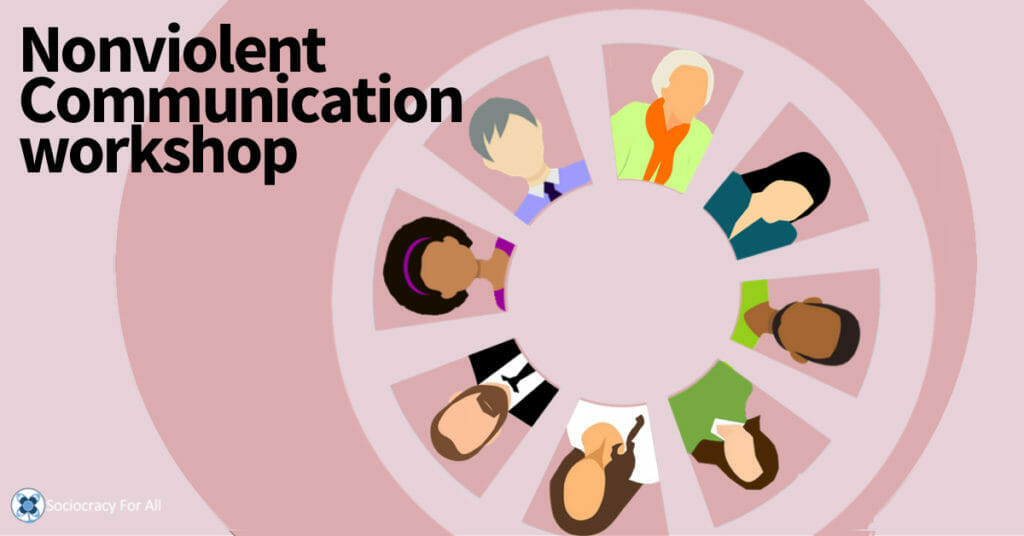Performance reviews are a useful way of receiving feedback from the people who know you best in your role in your organization – your coworkers. The person whose performance is reviewed is called the focus person. Imagine you would want to harvest the feedback from the people you work with, which would make you the focus person. How do you go about it?
Who should be involved?

The first step is to have the right people in the room. The goal of performance reviews is to give feedback to you on your role(s) in the organization. You can do a performance review in your circle if you are only part of one circle. Performance reviews can also be done by a group of members who don’t usually form a circle: for people in linking roles (leader or delegate), you need the perspective of all circle layers you are a part of. If there is substantial interaction to another circle (for instance in a hand-off to a more specific “sub” circle), then one or two members from that circle can be invited to the performance review. The idea is that every level relating to the focus person is represented. Not everyone in a related circle needs to be invited, keeping the group to a workable group size.
The focus person
The focus person is the person reviewed by their fellow co-workers and
- determines the members of the performance review
- sets a date and time for the performance review
- appoints a facilitator
- gives the members of the performance review access to relevant documents.
How to run a performance review
Below is a possible format for performance reviews. Other formats are possible if the basic objectives of the performance can be supported in the new format: the feedback in the performance review represents all relevant and related levels from the organization (transparency), consists of members who know the focus person well (for the feedback to be useful and effective) and includes a variety of voices (equivalence of voices).
Check-in
Check-ins are an essential part of every sociocratic meeting (see the chapter on meeting format on the website), just as consent to who fills roles and what the process (agenda) of the meeting will be. The performance review process follows the regular meeting pattern.
First round: what has gone well?
The content part of the meeting consists of three parts. First, the group does one round on what the focus person has achieved in the areas of content, process, and interpersonal interaction. Without any expectation of completeness, here are some possible statements that would include effective feedback in that round, both by the point person and by the other participants of the performance review. Good feedback in performance reviews includes general assessments (while making crystal clear that they are no absolute truth) and specific examples for illustration. Describe the impact the point person’s actions and way of being have on you.
Examples
- “I enjoy your leadership style. I experience you as reliable, for instance when it got forgotten to call the electrician and you noticed that on time and were able to intervene successfully.”
- “I appreciate your voice in the circle. What you say always seems to add to the discussion. I very much admire how you always pass when you do not have anything new or relevant to say. To me, that just makes your voice more valuable because you seem to choose wisely what needs to be said when without taking yourself too seriously.”
- “I think your energy is great. Your attitude is positive and genuine, you seem to give this circle a sense of ‘we can do this’. I loved when you pulled out that diagram a few meetings back that showed all the ways of dealing with an objection. What I noticed was how important it was for the circle, and certainly for me, to be aware that we have options. You really moved the circle forward there in my view.”
- “I love how you seem to be the calm center of the circle. Even when people are stuck or excited and want to do everything at the same time, you keep calm, and in my opinion that contributes so much to the group because you’re a needed counterpart to us. That gives me some piece of mind because I know we might drop things but you will noticed. That also shows in your writing minutes, they are always correct and thorough and organized. That supports us all in doing our work.”
Second round in performance reviews: what could be improved?

In the next round, people are going to share what they would like to see improved. Everyone speaking should remember that, in our culture, this can be hard to hear because, in everyone’s past, ideas for improvement have been expressed using blame. To counteract, make an effort to be kind, loving and self-responsible – without compromising on what is true for you.
It helps a lot to keep the phrase “this is not about you, it is just that I…” in your mind. Talk about yourself and the impact of the focus person on how your needs are met or not met. Do not interpret their actions without making clear that you are interpreting and assigning meaning to their actions. More often than not, when we assign other people’s actions meaning, we are at least a little off.
So we cannot talk about our judgments? Yes, we can. Hearing your judgments is very valuable feedback for the focus person (and everyone else in the room), but they are probably not entirely true. Just be transparent about that. There is no rule “you cannot talk about this”. There is just the appeal to be true and transparent, and in a world without right and wrong, “true” has to be what your experience is and what is true to you, and transparency means to share how you come to your truth.
Making a request in performance reviews
It is a good idea to make a request for the focus person during performance reviews. Requests are different from demands, in that the other person can say no. (And if they say no, it is because they are saying yes to another need of theirs.) A request has to be doable and specific. The chances of the other person saying yes to a request are higher when you reveal your own heart before you make the request.
When you make a request
- share the need of yours that is not met or that you are trying to meet.
- express how the other person could contribute to your needs being met. The other person is free to say yes or no.
Examples of “negative feedback”
Below are some examples of what is traditionally called “negative feedback” (which, in this case, is not really negative feedback but expressing someone’s need not getting met sufficiently). Non-violent communication (NVC) is a great add-on set of practices and values when we want to give valuable and effective people to someone. (Have a look at this page to learn more about NVC and sociocracy.)

- “I have a hard time staying engaged during meetings in general, and it helps me when a meeting is structured so I know what’s going on. I would love for you to support me in that by saying more often, what the frame is for one round, and where we are in the process. Maybe we could put a poster up of the different steps, and then you and we could refer to it? That is my request to you because it would help me be more relaxed in meetings.”
- “I appreciate that you are carrying so much of the load when it comes to our finances. I would like to express some concern because we don’t seem to have any redundancy, which also means no one can help you, and I would like to have some basic understanding of how our coop is doing financially to give me some peace of mind. I trust but any role should have some redundancy. I would like for someone to learn from you so it does not always have to be you doing our finances.”
- “I have to say there is something that is not working for me. I often come in for my shift after yours and find food on the counter that belongs into the fridge. I am worried about safety here and I am sure that is something we can all get behind. I’d love to hear your observations and what comes up for you hearing this.”
A little hard-to-hear example
- “I have something to say that might be a little hard to hear because it is clearly judgmental from my part. I am aware that this is probably just a story that is going on in my head, but it impacts the way we work together. It is important for me to feel comfortable in all our meetings, and I am currently not comfortable when we talk about IT tools. I am often picking up on some impatience, and in me, it sounds like all the IT was easy to understand while I am really struggling. Just taking care of myself for a second I would want to know that I am seen for my intentions which are to be productive and to be doing my best to learn the new tools. It is just something that seems to not flow as easily. I am actually curious how my judgement lands on you that, when it comes to that topic, you get annoyed and brief. I guess I already said my part: I am doing my best, and I’d like people to know that. If I am making up the part that you are annoyed with us and don’t think we’re trying hard enough, I’d like for you to share that so we can talk about it and are not stuck in projecting things about each other. If you do not hold any judgments there, then my request would be for you to be a bit more gentle with me because I get anxious when I do not feel competent, and I would sense judgment even where there is none, and this is hard for me and it is really impacting how I participate in our work here.”
Do you want to learn better how to give and request feedback in a kind and effective way? Join the next NVC training by clicking below!

Find an upcoming NVC class online
3 x 2h online class on non-violent communication with focus on governance. Saying what’s really going on with integrity, while being open to hearing the other person’s truth.
Taught by Jerry Koch-Gonzalez, certified trainer of Nonviolent Communication®.
Summary of performance reviews
- Performance reviews are a useful practice to receive feedback from people you work with.
- The person receiving feedback is called focus person.
- The focus person decides who will be part of the reviewing circle (taking into account transparency, effectiveness and equivalence), shares relevant information with them, appoints a facilitator and schedules the performance review session.
- As with any other meeting, we start a performance review session with a check-in and close with a check-out.
- The performance review circle members first share what has gone well, then what could be improved, and finally they may make a request.
- Be always mindful of how you give feedback!


